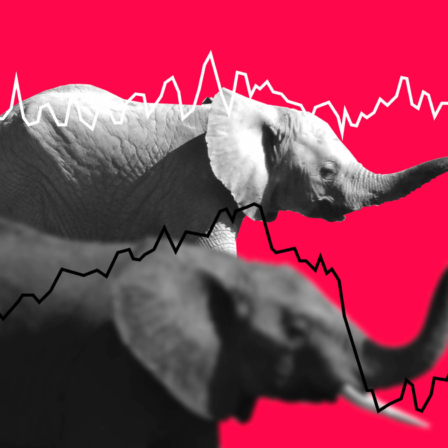When we consider taxation, we should pay attention to the changes already taking place in society as a result of digitalisation, such as trade moving online and work becoming fragmented in digital platforms. The decline in the number of jobs in heavy industry is a worldwide trend with no end in sight. At the same time, artificial intelligence is changing the nature of knowledge work and middle-class occupations, and is likely to render a large percentage of today’s occupations unnecessary.
Changes caused by digitisation erode the collected income and value added taxes, which make up a central part of the current tax base.
These changes erode the collected income and value added taxes, which make up a central part of the current tax base. Therefore, it is essential to examine what can be taxed effectively in a world that is becoming digitalised and how taxation can be targeted.
Information goods and services flee taxation
In the future, a significant part of people’s activities and exchange between people will not necessarily be visible as growing revenues of businesses. Digital commodities erode the tax base in two different ways. Firstly, when commodities become digitalised, their prices go down. Digitalisation also boosts activities between people in ways that will not necessarily be visible as monetary transactions. Digital commodities may increase well-being and the value obtained by the consumer, but exchange will not necessarily increase in the way it is expected to in the traditional value added tax system. Secondly, online commerce is global, and companies engaged in it are falling within the scope of Finnish taxation more rarely.
Long-term manifestations of the digital transformation include the increasingly common crypto- and peer-to-peer currencies, such as Bitcoin. Cryptocurrencies have promised that central banks will no longer be needed to regulate the availability of money and the stability of the currency. If the system of central banks disintegrates and transactions move into a different system, the tax authorities will face the challenge of how to control a decentralised system.
The foundation of the current tax system is eroding
In 2015, taxes and similar payments in Finland amounted to more than EUR 90 billion. Income taxes totalled EUR 32 billion, of which income taxes paid by households totalled EUR 27 billion. Income taxes paid by communities amounted to about EUR 4 billion, church taxes paid by communities to about EUR 100 million, and taxes at source on interest to about EUR 100 million. Statutory social insurance contributions, amounting to EUR 26 billion, were the next biggest source. The total for net worth taxes, which include the street maintenance fee, real estate tax, asset transfer tax, and inheritance and gift taxes, was EUR 3 billion. Taxes paid on goods and services totalled EUR 29 billion, of which the share of value added tax and turnover tax totalled EUR 18 billion. Energy taxes amounted to EUR 4 billion. The remaining taxes, excluding excise duty on alcohol, made up a very small part of the tax revenue. The company that paid the most corporation tax last year, excluding group companies, was Supercell, which brought a revenue of EUR 176 million to Finland.
Social insurance contributions and sources linked to taxation of work thus made up more than two thirds of the tax revenue. The share of value added tax was EUR 18 billion last year.
If the number of industrial jobs continues to decline, and service industries and retail trade become digitalised and operate across borders, the foundation of taxation in the form described above will collapse. We can only try to guess whether 20 or 90 per cent of the current tax revenue will be vanishing into the “bit space” during the next decade. In any case, the change will be significant.
The Nordic model, with its successful history, relies on a strong tax base. If we want to maintain at least some of the standard of the public system that has prevailed in Finland and the other European countries for the past fifty years, the structure of taxation must be reformed.
In the future, it will be justified to tax things that do not flee from the country but stay in place. Previously, these included work, inheritance and real estate. Today, the only one left seems to be real estate. The position of inheritance can, of course, be challenged. Digital platforms that would enable inheritance tax evasion do not yet exist, but it is increasingly easy for extremely wealthy people to evade inheritance tax by changing the location of their property. Still, inheritances are an interesting object for taxation as digitalisation directs capital to the hands of fewer and fewer people. However, the capability to tax inheritances is not likely to be on the increase.
Product development as a model for tax reform
One way to rethink taxation is to take advantage of the categorisation used by companies to categorise the different forms of product development:
- Small improvements. Nothing changes essentially, but measures are taken to improve existing products. Companies use about 95 per cent of their development resources for this.
- Replacing a whole device or process. The function of the device is reconsidered and, for example, the interfaces of the device are opened so that it can be used by a robot.
- “Destroying” the old device and developing a new one to replace it. This leads to a new category and to the formation of a market at best. The new output strives to replace several old products and services, and to perform their “service units” more efficiently.
If taxation is looked at using the above categorisation, the first category could be, for instance, making agreements on the exchange of information with digital platform companies. The agreement between the Estonian tax authorities and Uber is a good example of this. Under this agreement, Uber informs the state about what kind of work and how much of it has been done. This would be a small improvement, which would, however, not change the existing models, but would make the existing system more modern.
The second category would be the creation of whole new tax classes and a radical improvement of the system. Boosting the use of real estate, or a real estate tax reform is an example of this. In this case, economic activity is increased with the help of taxes. The revenue from value added tax increases as more efficient use of properties is encouraged, raising the value of those properties whose locations are favourable regarding the flows of people. Correspondingly, the value of properties in poor locations will fall. The forms of taxation related to the breakthrough of renewable energy are another example. Because renewable energy entails no additional costs after the initial investments, we could easily start taxing the purchase and transmission of electricity.
The third category would be the so called “reinvention” of taxation through totally new ways of collecting taxes. This would create entirely new earning and operating models for the state. Currently, the central factors in taxation are work, money and the state. However, totally new tax systems would bring changes to them, too. An especially attractive idea would be to directly tax the primary commodities of the digital age, such as computational capacity, robotics used in production, printing and repair, artificial intelligence, and electricity.
Examples of what could be taxed
Real estate
Properties are used inefficiently in Finland. Based on a rough estimate, we have four times as many properties as would be required in relation to momentary demand. The use of properties could be optimised by increasing the number of people using them and living in them. Office facilities could be used overnight. Taxes could be increased in stages, for example, based on the distance of the property from regions that are growing. The tax would be highest in densely populated areas and it would fall to almost zero the further away from cities and centres the location is.
This kind of new taxation aims at using the assets that are tied to a location, and taxing assets that are not used. Such assets include real estate, land and forest areas, and other similar property. The new forms of taxation must increase the value provided by the location. New types of real estate tax will steer value creation, as they encourage people to take advantage of the existing infrastructure as efficiently as possible. At the same time, revenues can be collected to the state treasury.
Energy
Energy is part of the system related to properties and their use. Energy production is always tied to the location and the infrastructure required in the production. Energy also has to be transmitted somewhere. Therefore, it is a good ‘source’ for taxation.
The use of coal and other fossil fuels in energy production will be given up in a few decades. Finland, too, is committed to transferring to entirely carbon-free energy production by 2030 . The need for taxing the harmful effects of energy production will thus disappear.
After the costs of founding, the production price of renewable energy will fall close to zero, which means that no costs will be incurred from the production itself. In many countries, the spot price of renewable energy is already close to zero at certain times of the day. Because of transmission and servicing costs, energy will never be entirely free, although it will be very close to that. Placing a solar panel or a wind turbine at the property will also improve the energy efficiency of that property. At some point, we will be in a situation in which we have abundant energy. When there is no longer any need to tax energy production because of its harmful effects, we may want to consider whether the energy that is almost free could be a taxed in a new way.
Transmission and consumption of electricity
Taxing real estate could encourage to maximal utilisation of properties. The taxation of electricity could be directed from production to usage.
An energy tax could also be directed at the electricity trade and especially to the transmission of electricity. Taxing the transmission of electricity would create a situation in which energy would cost more if it were produced by someone else or produced far away. In other words, electricity produced by people themselves, and self-sufficient devices and properties would be excluded from the tax. If people use energy that they have not generated themselves, they have to pay for it through taxes.
Once we have moved to using electric vehicles, driving as such will no longer cost anything and fuel taxes will practically disappear. At worst, robotised electric cars may be used like cars with a combustion engine, which means that they will sit waiting on the streets or drive empty around the blocks. In that case, charging for the use of electricity would be an environmental protection tax that would steer people to use vehicles efficiently and smartly. In addition, it would be possible to charge for the use of roads in the very near future, with pricing based on the level of congestion on the road.
Tax on the collection of personal data
Personal data has been classified as an asset similar to money by the World Economic Forum, among others. Utilisation of personal data is therefore at the core of the earnings models of modern companies.
The EU’s personal data regulation enables the taxation of collection of personal data.
According to the European understanding of ownership, an individual owns the information concerning him or her, or the right to that information can be considered a basic right. However, this is only realised at the level of principle. Because personal data is an asset, significant utilisation of data, i.e. data integration, could also be subject to taxes. When the EU’s personal data regulation enters into force, companies will have to document their data collection in detail. This documentation will reveal what kind of data companies collect and how much of it they collect. It will make it possible to tax the collection of data.
The duty to document may also have positive knock-on effects because it makes people understand that their information is constantly collected for some purpose. According to some claims, companies like Google and Facebook cannot wholly take advantage of data integration as they worry about people’s reactions when they discover the extent of the data collected on them.
This possibility has become emphasised in the Nordic countries. Unlike people in the Anglo-Saxon countries, the Nordic nations still trust politics and collective decision-making to a considerable extent. However, it is important that taxation does not prevent the gathering and collection of data. Finland is a poor country in terms of capital, so we don’t want it to be poor in terms of data, too.
Well-being tax
More and more data is created when products are consumed. Based on this data, we will obtain more information about commodities and their undesirable effects on health or the environment. This data could be utilised by targeting taxes better, for example, at products that are known to have harmful effects. This way we would also increase the impact of steering through taxation.
Peer-to-peer currencies and digital platform services
Favouring cryptocurrencies could help attract companies engaged in the platform economy to Finland. A new currency could be introduced in stages in a manner approved by the state, and employers would be obliged to report payments. This way the tax authorities’ right to obtain information would remain relatively strong, even if the banking and currency system became decentralised.
The operation of platform companies in Finland should be made easy and efficient in terms of taxes. Instead of talking only about tax havens, we should focus on how the state could obtain community tax revenue from digital companies and their business outside Finland’s borders, and not only from business that is conducted through the platforms in Finland. The business ecosystems forming around these companies are especially significant. A company that operates internationally uses a lot of specialised services that often employ more people than the platform company itself (e.g. legal, marketing and financial administration services).
Future taxes: commodities instead of money?
The tax system must be reformed in a radical way by identifying new things that can be taxed and principles that will drive society forward.
In taxation, the third reform category, the radical reinvention of things, corresponds to the idea of changing the object of taxation. In addition to money, taxes were earlier collected also in grain and other commodities. It is a good reminder that taxes would not need to be paid only in money. In the future, could the state also start using the most valuable resources instead of just money? These could include robotics, or the capacities of server rooms, 3D printing or artificial intelligence.
Instead of money, could the state also start using the most valuable resources, such as robotics, or the capacities of server rooms or artificial intelligence?
The state could use these resources for its own purposes or, alternatively, sell them on. The possibility for companies in specific industries to pay their taxes using not money, but the commodities they produce, could also promote the creation of high value-added services in Finland.
Taxation must steer positive development in society
As a consequence of technological development, an increasing part of the population may never have a job. Inactivity is difficult to tax, so taxation must be targeted at other production factors. These are the collection of energy (light, changes in temperatures, radio waves and motion) and immovable property, both of which cannot disappear anywhere. Taxation related to them must, however, lead society in a positive direction. It should therefore not be targeted at electricity production, which is almost free in terms of its marginal costs, but at the use of electricity.
It seems that the current tax base will dry up at some point, so it is obvious that we will need new ways of taxation. We must be able to create new objects of taxation and taxation principles that will steer society without slowing down the utilisation of opportunities provided by technology. Taxes on well-being, energy and cryptocurrencies are examples of new taxes. But even they are not permanent solutions in terms of safeguarding a stable tax base for the future welfare society.
Taxation is linked to how value is created in the particular development stage of society and the economy. In the digital age, it is not done in the same way as in the industrial age, and taxation therefore needs to be as pragmatic as possible. What is essential is the capability to create new tax bases to enable the state to fund its operations and create the preconditions for inclusive and sustainable well-being.









Other articles
Bear with it.